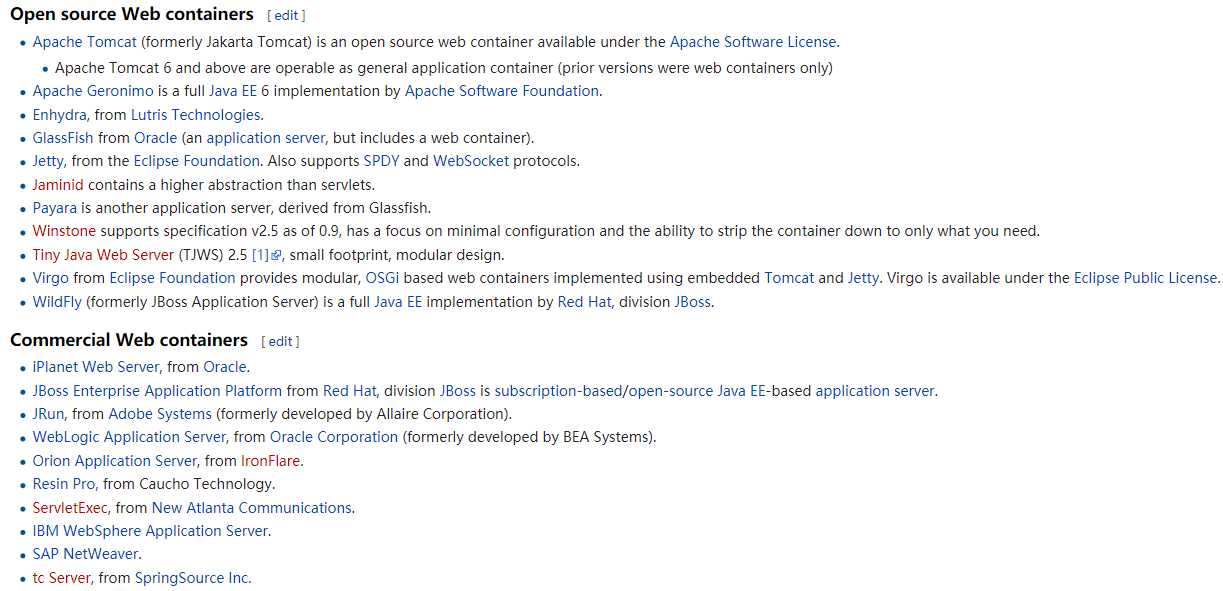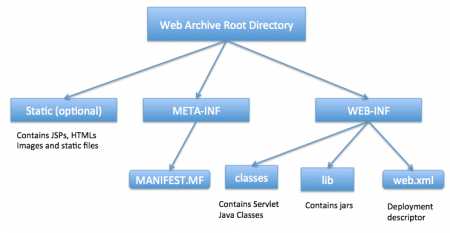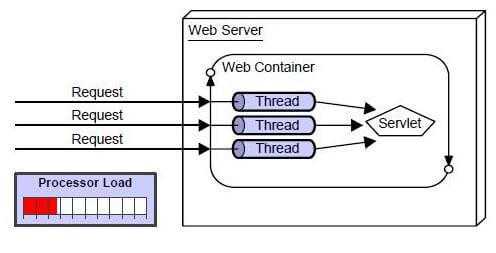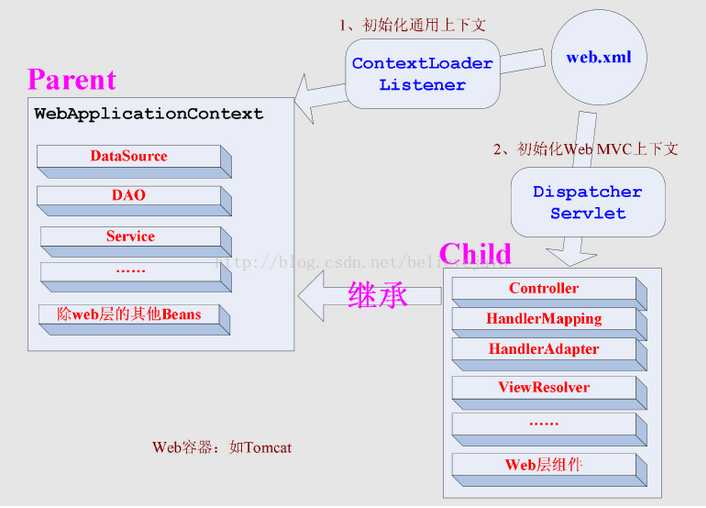标签:cap table classes include 自动 auto -- xml配置 ports
背景
上世纪90年代,随着Internet和浏览器的飞速发展,基于浏览器的B/S模式随之火爆发展起来。最初,用户使用浏览器向WEB服务器发送的请求都是请求静态的资源,比如html、css等。 但是可以想象:根据用户请求的不同动态的处理并返回资源是理所当然必须的要求。
web容器也叫servlet容器,负责servlet的生命周期,映射url请求到相应的servlet。
A web container (also known as a servlet container;[1] and compare "webcontainer"[2]) is the component of a web server that interacts with Java servlets. A web container is responsible for managing the lifecycle of servlets, mapping a URL to a particular servlet and ensuring that the URL requester has the correct access-rights. A web container handles requests to servlets, JavaServer Pages (JSP) files, and other types of files that include server-side code. The Web container creates servlet instances, loads and unloads servlets, creates and manages request and response objects, and performs other servlet-management tasks. A web container implements the web component contract of the Java EE architecture. This architecture specifies a runtime environment for additional web components, including security, concurrency, lifecycle management, transaction, deployment, and other services.
常见的web容器如下:

在web容器中,web应用服务器的结构如下:

1.普通servlet实现页面访问

1.1 实例1:使用web.xml实现一个http服务
实现一个简单的servlet
package com.howtodoinjava.servlets; import java.io.IOException; import java.io.PrintWriter; import javax.servlet.ServletException; import javax.servlet.http.HttpServlet; import javax.servlet.http.HttpServletRequest; import javax.servlet.http.HttpServletResponse; public class MyFirstServlet extends HttpServlet { private static final long serialVersionUID = -1915463532411657451L; @Override protected void doGet(HttpServletRequest request, HttpServletResponse response) throws ServletException, IOException { response.setContentType("text/html;charset=UTF-8"); PrintWriter out = response.getWriter(); try { // Write some content out.println("<html>"); out.println("<head>"); out.println("<title>MyFirstServlet</title>"); out.println("</head>"); out.println("<body>"); out.println("<h2>Servlet MyFirstServlet at " + request.getContextPath() + "</h2>"); out.println("</body>"); out.println("</html>"); } finally { out.close(); } } @Override protected void doPost(HttpServletRequest request, HttpServletResponse response) throws ServletException, IOException { //Do some other work } @Override public String getServletInfo() { return "MyFirstServlet"; } }
web.xml配置servlet
<?xml version="1.0"?> <web-app xmlns="http://xmlns.jcp.org/xml/ns/javaee" xmlns:xsi="http://www.w3.org/2001/XMLSchema-instance" xsi:schemaLocation="http://xmlns.jcp.org/xml/ns/javaee http://xmlns.jcp.org/xml/ns/javaee/web-app_3_0.xsd" version="3.0"> <welcome-file-list> <welcome-file>/MyFirstServlet</welcome-file> </welcome-file-list> <servlet> <servlet-name>MyFirstServlet</servlet-name> <servlet-class>com.howtodoinjava.servlets.MyFirstServlet</servlet-class> </servlet> <servlet-mapping> <servlet-name>MyFirstServlet</servlet-name> <url-pattern>/MyFirstServlet</url-pattern> </servlet-mapping> </web-app>
1.2 编程方式实现一个http服务请求
不需要xml
package com.journaldev.first; import java.io.IOException; import java.io.PrintWriter; import java.util.Date; import javax.servlet.ServletException; import javax.servlet.annotation.WebInitParam; import javax.servlet.annotation.WebServlet; import javax.servlet.http.HttpServlet; import javax.servlet.http.HttpServletRequest; import javax.servlet.http.HttpServletResponse; /** * Servlet implementation class FirstServlet */ @WebServlet(description = "My First Servlet", urlPatterns = { "/FirstServlet" , "/FirstServlet.do"}, initParams = {@WebInitParam(name="id",value="1"),@WebInitParam(name="name",value="pankaj")}) public class FirstServlet extends HttpServlet { private static final long serialVersionUID = 1L; public static final String HTML_START="<html><body>"; public static final String HTML_END="</body></html>"; /** * @see HttpServlet#HttpServlet() */ public FirstServlet() { super(); // TODO Auto-generated constructor stub } /** * @see HttpServlet#doGet(HttpServletRequest request, HttpServletResponse response) */ protected void doGet(HttpServletRequest request, HttpServletResponse response) throws ServletException, IOException { PrintWriter out = response.getWriter(); Date date = new Date(); out.println(HTML_START + "<h2>Hi There!</h2><br/><h3>Date="+date +"</h3>"+HTML_END); } /** * @see HttpServlet#doPost(HttpServletRequest request, HttpServletResponse response) */ protected void doPost(HttpServletRequest request, HttpServletResponse response) throws ServletException, IOException { // TODO Auto-generated method stub } }
2.spring mvc实现页面访问
2.1 web.xml方式

示例:
<web-app xmlns="http://java.sun.com/xml/ns/javaee" xmlns:xsi="http://www.w3.org/2001/XMLSchema-instance" xsi:schemaLocation="http://java.sun.com/xml/ns/javaee http://java.sun.com/xml/ns/javaee/web-app_2_5.xsd" version="2.5"> <display-name>Gradle + Spring MVC Hello World + XML</display-name> <description>Spring MVC web application</description> <!-- For web context --> <servlet> <servlet-name>hello-dispatcher</servlet-name> <servlet-class>org.springframework.web.servlet.DispatcherServlet</servlet-class> <init-param> <param-name>contextConfigLocation</param-name> <param-value>/WEB-INF/spring-mvc-config.xml</param-value> </init-param> <load-on-startup>1</load-on-startup> </servlet> <servlet-mapping> <servlet-name>hello-dispatcher</servlet-name> <url-pattern>/</url-pattern> </servlet-mapping> <!-- For root context --> <listener> <listener-class>org.springframework.web.context.ContextLoaderListener</listener-class> </listener> <context-param> <param-name>contextConfigLocation</param-name> <param-value>/WEB-INF/spring-core-config.xml</param-value> </context-param> </web-app>
2.2 编码方式
public class MyWebAppInitializer implements WebApplicationInitializer { @Override public void onStartup(ServletContext container) { // Create the ‘root‘ Spring application context AnnotationConfigWebApplicationContext rootContext = new AnnotationConfigWebApplicationContext(); rootContext.register(AppConfig.class); // Manage the lifecycle of the root application context container.addListener(new ContextLoaderListener(rootContext)); // Create the dispatcher servlet‘s Spring application context AnnotationConfigWebApplicationContext dispatcherContext = new AnnotationConfigWebApplicationContext(); dispatcherContext.register(DispatcherConfig.class); // Register and map the dispatcher servlet ServletRegistration.Dynamic dispatcher = container.addServlet("dispatcher", new DispatcherServlet(dispatcherContext)); dispatcher.setLoadOnStartup(1); dispatcher.addMapping("/"); } }
内部实现

3.spring boot
继承了spring mvc的框架,实现SpringBootServletInitializer
package com.mkyong; import org.springframework.boot.SpringApplication; import org.springframework.boot.autoconfigure.SpringBootApplication; import org.springframework.boot.builder.SpringApplicationBuilder; import org.springframework.boot.web.support.SpringBootServletInitializer; @SpringBootApplication public class SpringBootWebApplication extends SpringBootServletInitializer { @Override protected SpringApplicationBuilder configure(SpringApplicationBuilder application) { return application.sources(SpringBootWebApplication.class); } public static void main(String[] args) throws Exception { SpringApplication.run(SpringBootWebApplication.class, args); } }
然后controller
package com.mkyong; import java.util.Map; import org.springframework.beans.factory.annotation.Value; import org.springframework.stereotype.Controller; import org.springframework.web.bind.annotation.RequestMapping; @Controller public class WelcomeController { // inject via application.properties @Value("${welcome.message:test}") private String message = "Hello World"; @RequestMapping("/") public String welcome(Map<String, Object> model) { model.put("message", this.message); return "welcome"; } }
总结:
1.servlet的本质没有变化,从web框架的发展来看,web框架只是简化了开发servlet的工作,但还是遵循servlet规范的发展而发展的。
2.servlet的历史发展,从配置方式向编程方式到自动配置方式发展
3.spring mvc框架的分组:root和child(可以有多个dispatcherservlet),多个child可以共享root,child直接不共享
参考文献:
【1】https://en.wikipedia.org/wiki/Web_container
【2】https://baike.baidu.com/item/servlet/477555?fr=aladdin
【3】https://www.javatpoint.com/servlet-tutorial
【4】https://www.journaldev.com/1854/java-web-application-tutorial-for-beginners#deployment-descriptor
【5】https://blog.csdn.net/qq_22075041/article/details/78692780
【6】http://www.mkyong.com/spring-mvc/gradle-spring-mvc-web-project-example/
【7】http://www.mkyong.com/spring-boot/spring-boot-hello-world-example-jsp/
web框架的前生今世--从servlet到spring mvc到spring boot
标签:cap table classes include 自动 auto -- xml配置 ports
原文地址:https://www.cnblogs.com/davidwang456/p/10297476.html